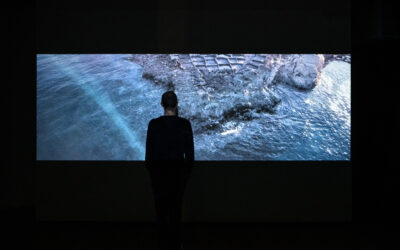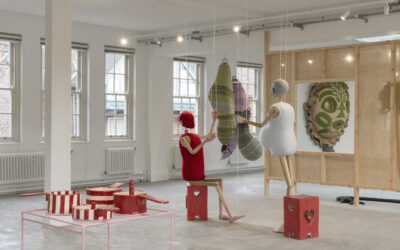Huma Bhabha: Ambiguous Otherness
With her first monographic exhibition in a French institution, Huma Bhabha seamlessly weaves together diverse eras, materials, and iconic forms to create thought-provoking works that explore anthropomorphic and hybrid presences.
The exhibition, housed at Montepellier Contemporaine, showcases an array of works, each a testament to Bhabha’s unique artistic vision. Spanning cork and polystyrene sculptures, bronzes, drawings on paper, photographs, photogravures, and ceramics: the collection forms a welcoming horde. The journey begins with the pivotal sculpture Centaur (2000) and unfolds into a mesmerising display of large-scale sculptures, assemblages, collages, and layering of materials like wire, clay, and cork. These works evoke totem poles or archaic statues, enriched by the use of paint or coloured polystyrene.
At the core of Bhabha’s work is the recurring theme of the figure—ubiquitous yet elusive, suggesting an ambiguous otherness that transcends time and space. Her art draws from a vast repertoire of references, bridging the gap between the academic and popular culture. From ancient statuary to science fiction films, the result is a universalism of forms that invites viewers to ponder the interconnectedness of human experiences.
Anatomical details in Bhabha’s sculptures often blend human elements with those of animals like monkeys, owls, dogs, or wolves. In her drawings on photographs, humans and animals emerge against devastated landscapes, with the subtle use of pastels softening the potential metamorphoses or hybridization depicted. Throughout the exhibition, links and traces persist within a wide range of presence and affirmation, inviting contemplation on themes of anachronism, layering, assemblage, fragmentation, hybridization, otherness, and the formation of groups—a pack, in Bhabha’s terminology.
A Fly Appeared, and Disappeared is a journey through the complexities of an ever-changing world which promises to astonish and amaze while underscoring the depth of an artist unafraid to confront and transcend the challenges of our times. Visitors have the opportunity to explore the layers of Bhabha’s world until January 28th, 2024.




Images: “Huma Bhabha. A Fly Appeared, and Disappeared”, MO.CO., Montpellier, 2023.
© Huma Bhabha. Courtesy de l’artiste, Xavier Hufkens, Brussels; David Kordansky Gallery; David Zwirner. Photos: Marc Domage
Be part of our
community
Explore art, photography and design that inspires you. Discover new artists,
follow your favorites and connect with the creative community.
Small Amnesias – Kunsthalle Neuwerk
Explore ‘Small Amnesias’ at Kunsthalle Neuwerk, an evocative exhibition by Maltese artist Vince Briffa. Immerse in a unique blend of video art and soundscapes that echo Malta’s rich heritage, expertly curated by Nina Maier. A sensory journey of memory, identity, and place
Reevaluating Western Perspectivism
Dev Dhunsi, a Norwegian-Indian multidisciplinary artist and photographer based in Stockholm is currently presenting his inaugural solo exhibition at MELK, Oslo. “Encircling Stories” features images captured during Dhunsi’s seven-year exploration, spanning from Punjab to Goa, traversing diverse regions of India by train. The exhibition reveals evolving relationships with land, highlighting the complexities of a region undergoing agricultural challenges, monoculture threats, and dispossession.
House & Garden
Charleston Lewes is currently hosting Through the Joy of the Senses an exhibition by contemporary artist Jonathan Baldock. The solo show explores Baldock’s fascination with sculptural form, craft traditions, and folklore. The selection resonates with Lewes’s historical and cultural context, weaving a narrative inspired by the town’s rich folklore, myths, and legends.
Powered by
Publications
Social
Legal



